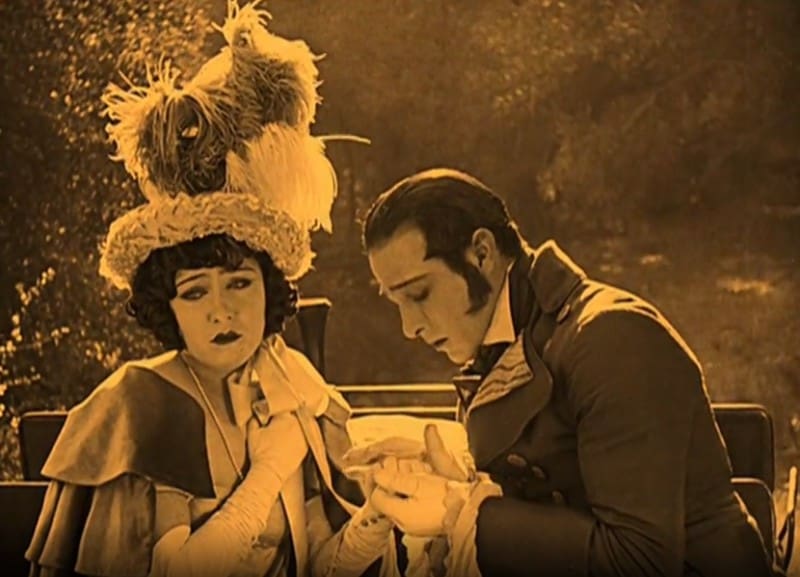
Beyond the Classics is a recurring column in which Emily Kubincanek highlights lesser-known old movies and examines what makes them memorable. In this installment, she tells the story of Gloria Swanson and Rudolph Valentino’s only movie together, Beyond the Rocks.
Rarely did two mega movie stars appear in the same film during the silent era of Hollywood. Someone’s name always had to be below the other’s in the credits, and many stars were not satisfied with second billing. One exception is when Gloria Swanson and Rudolph Valentino appeared together in Beyond the Rocks in 1922. This rare collaboration was lost to history for decades. However, a copy has since been found and restored for us to see how two stars navigated captivating an audience together. The diversion of career paths Valentino and Swanson took immediately following Beyond the Rocks is even more interesting than the film itself, affecting how we view this movie today.
By 1922 when Beyond the Rocks was released, Gloria Swanson was an established player in Hollywood’s power games. Since the early days, she had been a part of movie-making and had grown into her own type of star outside of the archetypes her competitors had. Swanson was not simply a vamp nor a saint, but always a fascinating and glamorous woman. She outgrew the roles legendary director Cecil B. DeMille gave her at the beginning of her career and moved to what would become Paramount Pictures in the hopes of having more control over the movies in which she starred.
At this time and for decades following, stars rarely had much power within the studio system, and Swanson was still indebted to studio executives. When she was assigned the leading role in the adaptation of Elinor Glyn’s scandalous novel Beyond the Rocks, Paramount believed it was forcing her to relinquish her diva mentality to make room for a star she did not care for. However, she and her costar Valentino had been friends for years, and both looked forward to finally working together.
Although, Valentino’s career had not been a steady rise to stardom like Swanson’s had been. Valentino was riding the high of an overnight success from his two hits in 1921, The Four Horsemen of the Apocalypse and The Sheik, when signing on to make Beyond the Rocks. His status as the leading sex symbol of Hollywood was compounded by quickly becoming involved with costume designer Natacha Rambova, who immediately believed her soon-to-be husband needed better roles and more money. They quickly became Hollywood’s Jazz Age “It” couple, but their relationship was not a dream come true for Valentino’s collaborators.
Rambova designed the costumes for Beyond the Rocks and helped contribute to its lavish style, which is easily one of the film’s best aspects. However, she also caused friction on set with Valentino and everyone else working on the movie. While many expected Swanson to be the diva and cause trouble during filming, Rambova openly expressed how much she hated the film. She thought Glyn’s story “costume-drama trash” and “completely unworthy of Valentino,” but nonetheless produced fantastic work on his costumes.
Her control over Valentino and his work began getting in the way of filming, and studio head Jesse Lasky received several complaints from director Sam Wood and other technicians on the film. No matter how well Valentino performed or how much money his appearance gained for the studio, Rambova’s personality would affect where his career would go following Beyond the Rocks. Thanks to her rude displays on set, Swanson and Wood told Valentino to his face that they would never work with him again.
Beyond the Rocks is a cut and dry melodramatic romance, one probably like many others you’ve seen from early Hollywood. Swanson plays Theodora, a young woman who marries an older gentleman for his money. However, she cannot shake an earlier encounter with the man of her dreams. While on a boat ride one day, Valentino’s character Lord Hector rescues Theodora from drowning. She falls overboard, and the two gorgeous people naturally fall in love. Their affair is kept a secret for a time to ensure Theodora maintains her husband’s fortune and she can support her family. However, her husband eventually finds out and willingly goes on a dangerous expedition in Africa, where he dies, freeing the lovers to marry one another.
If you approach this movie for the story, you might be disappointed, but its tepid story ends up letting audiences focus on the two stars and the atmosphere they create on-screen. Whenever Swanson bats her eyes or Valentino takes her in his arms, the circumstances of their relationship are an afterthought. Everyone rushing to theaters to see Swanson and Valentino together were there for chemistry and a luscious romantic world to escape to for a bit, which is precisely what Beyond the Rocks delivers.
Despite being somewhat tame compared to the Pre-Code movies that would follow the silent era, director Sam Wood was acutely aware of the Hays’ Code’s looming threat when filming Valentino and Swanson’s love scenes. After all, the sex appeal was what everyone watched Valentino movies for, but the United States could only handle so much sensuality. Kisses could only take up ten feet of film at the time, but Wood filmed longer kisses for the European audiences. Glyn prided herself in her coaching of the stars, giving them tips on representing the “psychological realism” in her novels. However, Americans thought this film much less sexy than Valentino’s other films, perhaps because of the cuts made for censors.
Neither star would ever get to see their work in Beyond the Rocks again after its initial release, and their careers went in drastically different directions after 1922. Despite remaining a national celebrity, Valentino could not maintain a steady career. Not long after this movie was released, Valentino hired a manager who convinced him to go on a dancing tour to capitalize on his legions of female fans around the country. This further put the emphasis on his sexuality rather than his acting ability. Rambova continued to maintain control over his career, negotiating his following projects, which did poorly in the United States. They struggled to find films that would further his career, and the stress of maintaining his deteriorating public image caused Valentino to develop deadly ulcers.
What helped catapult him to stardom eventually became his downfall. His sex appeal limited him to typecasting, and his sensational personal life was wrought with rumors even more scandalous than his love scenes on screen. He made his final film in 1926 before becoming unexpectedly ill and dying at 31. His death was a national tragedy, and today we look back in sorrow when remembering his short career, especially when comparing it to Swanson’s lifelong career.
Swanson continued to make films successfully until sound became commonplace in 1928. Initially, she adapted well to sound, even earning an Oscar nomination for her performance in the 1929 sound film The Trespasser. Although, her over-the-top acting quickly became out of style, and Hollywood was not kind to older actresses. Her career decline was not permanent, though, as she made a comeback with her fantastic performance in Sunset Boulevard. Now considered her best work, Swanson capitalized on the mythos of her career in Hollywood and its decline for her role as has-been silent star Norma Desmond. Like many other Old Hollywood stars of her time, she transitioned to television and theater in her later life. This kept her celebrity alive, and she died a respected and renowned star in 1983.
Before passing away, Swanson voiced her desire to find one of her favorite films she worked on, Beyond the Rocks. However, Beyond the Rocks was considered a lost film for the rest of her life. For much of 80 years, only one clip of the film remained until two reels of a nitrate print were unearthed in a museum in the Netherlands in 2003. A restored copy was screened at the Cannes Film Festival in 2005, putting one of Swanson’s favorite films on display at cinema’s most renowned festivals.
When Beyond the Rocks first came out in 1922, it was far from considered the kind of art-house and innovative movies that are screened at Cannes today. But finding a once-lost film means more than just the content of the movie itself. Uncovering a lost film from a bygone era of filmmaking helps us visualize the legends and stories that remain from that time. Martin Scorsese talks about the value of finding Beyond the Rocks best in his intro to the restored version, “Every film found restores another piece of our collective memory, our sense of our past, and our history. The greatest actors of the silent era had a rare intensity—emotional, physical, almost spiritual. They had to seize us right from the start, with their own inner power and luminosity. As you will see, that’s exactly what Valentino and Swanson, both at the peak of their powers, do in Beyond the Rocks.”
One hundred years have passed since Swanson and Valentino worked together for the first and last time. Even though the surviving film is deteriorating and still missing a scene Swanson talked about before she died, the two stars’ radiance can still be felt today watching the restored version. It’s easy to read about how mesmerizing Gloria Swanson and Rudolph Valentino were, but watching it is a different experience entirely, one that cannot be taken for granted as more of movie history continues to vanish every day.
You can rent Beyond the Rocks on Kino Now.
Related Topics: Beyond the Classics

